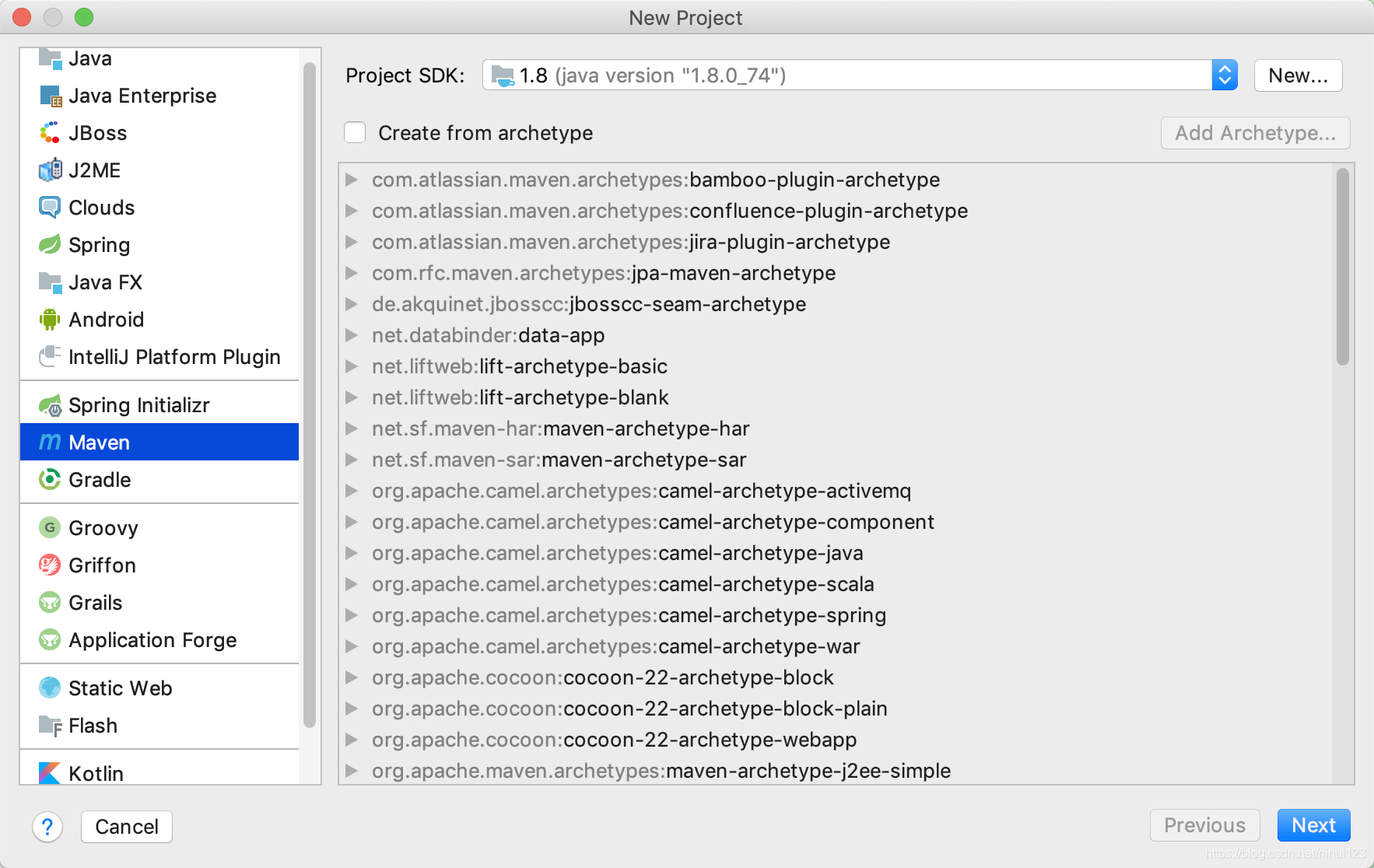版权声明:本文为博主原创文章,遵循 CC 4.0 BY-SA 版权协议,转载请附上原文出处链接和本声明。
导语
使用Mybatis的时候通常会创建很多的映射文件以及创建很多的Model对象,相对来说比较麻烦也有很多的重复的工作。下面就来使用一个Mybatis Dao层代码生成器。
文章目录
开始使用Mybatis Generator 代码生成器
创建一个Maven项目

填写GroupID和ArtifactId

创建完成项目目录

在Resource文件夹下创建generator.properties
内容如下
jdbc.driverLocation=/mysql/mysql-connector-java/5.1.37/mysql-connector-java-5.1.37.jar
jdbc.driverClass=com.mysql.jdbc.Driver
jdbc.connectionURL=jdbc:mysql://localhost:3306/test
jdbc.userId=root
jdbc.password=123456
当然上面的内容需要根据自己的本地目录进行修改。
在Resource文件夹下创建generatorConfig.xml
内容如下
在下面内容中有很多的注释以及内容都是从网上百度而来。希望大家在使用的时候可以根据自己的项目内容来确定。
<?xml version="1.0" encoding="UTF-8"?>
<!DOCTYPE generatorConfiguration
PUBLIC "-//mybatis.org//DTD MyBatis Generator Configuration 1.0//EN"
"http://mybatis.org/dtd/mybatis-generator-config_1_0.dtd">
<generatorConfiguration>
<!--导入属性配置 -->
<properties resource="generator.properties"></properties>
<!--指定特定数据库的jdbc驱动jar包的位置 -->
<classPathEntry location="${jdbc.driverLocation}"/>
<context id="default" targetRuntime="MyBatis3">
<!-- optional,旨在创建class时,对注释进行控制 -->
<commentGenerator>
<property name="suppressDate" value="true" />
</commentGenerator>
<!--jdbc的数据库连接 -->
<jdbcConnection driverClass="${jdbc.driverClass}" connectionURL="${jdbc.connectionURL}" userId="${jdbc.userId}" password="${jdbc.password}">
</jdbcConnection>
<!-- 非必需,类型处理器,在数据库类型和java类型之间的转换控制-->
<javaTypeResolver >
<property name="forceBigDecimals" value="false" />
</javaTypeResolver>
<!-- Model模型生成器,用来生成含有主键key的类,记录类 以及查询Example类
targetPackage 指定生成的model生成所在的包名
targetProject 指定在该项目下所在的路径
-->
<javaModelGenerator targetPackage="org.nihui.po" targetProject="src/main/java">
<!-- 是否对model添加 构造函数 -->
<property name="constructorBased" value="true"/>
<!-- 是否允许子包,即targetPackage.schemaName.tableName -->
<property name="enableSubPackages" value="false"/>
<!-- 建立的Model对象是否 不可改变 即生成的Model对象不会有 setter方法,只有构造方法 -->
<property name="immutable" value="true"/>
<!-- 给Model添加一个父类 -->
<property name="rootClass" value="com.nihui.UserHello"/>
<!-- 是否对类CHAR类型的列的数据进行trim操作 -->
<property name="trimStrings" value="true"/>
</javaModelGenerator>
<!--Mapper映射文件生成所在的目录 为每一个数据库的表生成对应的SqlMap文件 -->
<sqlMapGenerator targetPackage="org.nihui.domain" targetProject="src/main/java">
<property name="enableSubPackages" value="false"/>
</sqlMapGenerator>
<!-- 客户端代码,生成易于使用的针对Model对象和XML配置文件 的代码
type="ANNOTATEDMAPPER",生成Java Model 和基于注解的Mapper对象
type="MIXEDMAPPER",生成基于注解的Java Model 和相应的Mapper对象
type="XMLMAPPER",生成SQLMap XML文件和独立的Mapper接口
-->
<javaClientGenerator targetPackage="com.nihui.dao" targetProject="src/main/java" type="MIXEDMAPPER">
<property name="enableSubPackages" value=""/>
<!--
定义Maper.java 源代码中的ByExample() 方法的可视性,可选的值有:
public;
private;
protected;
default
注意:如果 targetRuntime="MyBatis3",此参数被忽略
-->
<property name="exampleMethodVisibility" value=""/>
<!--
方法名计数器
Important note: this property is ignored if the target runtime is MyBatis3.
-->
<property name="methodNameCalculator" value=""/>
<!--
为生成的接口添加父接口
-->
<property name="rootInterface" value=""/>
</javaClientGenerator>
<table tableName="user">
<!-- optional , only for mybatis3 runtime
自动生成的键值(identity,或者序列值)
如果指定此元素,MBG将会生成<selectKey>元素,然后将此元素插入到SQL Map的<insert> 元素之中
sqlStatement 的语句将会返回新的值
如果是一个自增主键的话,你可以使用预定义的语句,或者添加自定义的SQL语句. 预定义的值如下:
Cloudscape This will translate to: VALUES IDENTITY_VAL_LOCAL()
DB2: VALUES IDENTITY_VAL_LOCAL()
DB2_MF: SELECT IDENTITY_VAL_LOCAL() FROM SYSIBM.SYSDUMMY1
Derby: VALUES IDENTITY_VAL_LOCAL()
HSQLDB: CALL IDENTITY()
Informix: select dbinfo('sqlca.sqlerrd1') from systables where tabid=1
MySql: SELECT LAST_INSERT_ID()
SqlServer: SELECT SCOPE_IDENTITY()
SYBASE: SELECT @@IDENTITY
JDBC: This will configure MBG to generate code for MyBatis3 suport of JDBC standard generated keys.
This is a database independent method of obtaining the value from identity columns.
identity: 自增主键 If true, then the column is flagged as an identity column and the generated <selectKey>
element will be placed after the insert (for an identity column). If false, then the generated <selectKey> will be placed before
the insert (typically for a sequence).
-->
<!--<generatedKey column="" sqlStatement="" identity="" type=""/>-->
<!-- optional.
列的命名规则:
MBG使用 <columnRenamingRule> 元素在计算列名的对应 名称之前,先对列名进行重命名,
作用:一般需要对BUSI_CLIENT_NO 前的BUSI_进行过滤
支持正在表达式
searchString 表示要被换掉的字符串
replaceString 则是要换成的字符串,默认情况下为空字符串,可选
-->
<!--<columnRenamingRule searchString="" replaceString=""/>-->
<!-- optional.告诉 MBG 忽略某一列
column,需要忽略的列
delimitedColumnName:true ,匹配column的值和数据库列的名称 大小写完全匹配,false 忽略大小写匹配
是否限定表的列名,即固定表列在Model中的名称
-->
<!--<ignoreColumn column="PLAN_ID" delimitedColumnName="true" />-->
<!--optional.覆盖MBG对Model 的生成规则
column: 数据库的列名
javaType: 对应的Java数据类型的完全限定名
在必要的时候可以覆盖由JavaTypeResolver计算得到的java数据类型. For some databases, this is necessary to handle "odd"
database types (e.g. MySql's unsigned bigint type should be mapped to java.lang.Object).
jdbcType:该列的JDBC数据类型(INTEGER, DECIMAL, NUMERIC, VARCHAR, etc.),该列可以覆盖由JavaTypeResolver计算得到的Jdbc类型,
对某些数据库而言,对于处理特定的JDBC 驱动癖好 很有必要(e.g. DB2's LONGVARCHAR type should be mapped to VARCHAR for iBATIS).
typeHandler:
-->
<!--<columnOverride column="" javaType="" jdbcType="" typeHandler="" delimitedColumnName="" />-->
</table>
</context>
</generatorConfiguration>
配置Pom文件
内容如下
在POM中添加如下的一些内容。当然也可使用高版本的打包工具
<?xml version="1.0" encoding="UTF-8"?>
<project xmlns="http://maven.apache.org/POM/4.0.0"
xmlns:xsi="http://www.w3.org/2001/XMLSchema-instance"
xsi:schemaLocation="http://maven.apache.org/POM/4.0.0 http://maven.apache.org/xsd/maven-4.0.0.xsd">
<modelVersion>4.0.0</modelVersion>
<groupId>com.nh.mybatis</groupId>
<artifactId>generator</artifactId>
<version>1.0-SNAPSHOT</version>
<build>
<finalName>nihui</finalName>
<plugins>
<plugin>
<groupId>org.mybatis.generator</groupId>
<artifactId>mybatis-generator-maven-plugin</artifactId>
<version>1.3.2</version>
<configuration>
<!--<configurationFile>src/main/resources/generatorConfig.xml</configurationFile>-->
<verbose>true</verbose>
<overwrite>true</overwrite>
</configuration>
</plugin>
</plugins>
</build>
</project>
配置Maven项目启动
1、添加配置项

2、配置启动

3、在Command Line 中添加 mybatis-generator:generate -e配置。
运行效果
点击运行之后出现如下的效果。表示完成

项目路径变化为下图内容

总结
通过上面的方式可以快速高效的生成Mybatis的Dao层所需要的代码,但是为了项目的高效性,在生成之后我们还需要将这些文件移动到自己的项目中,然后在做一些定制化的开发,这样才能完全的适配与我们的项目,当然如果在使用的过程中项目比较简单的话也可以不使用这种方式,直接开发就可以了。这样的做法在一定程度上减少了项目编写代码量。